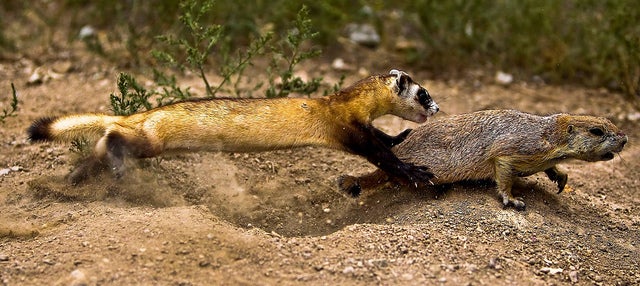Black-Footed Ferrets Recover from Near-Extinction -- Thanks to Artificial Insemination


If youre trying to save an endangered animal, you need to protect its habitat and change the human behaviors driving it toward extinction. But all that will be meaningless if the animals dont have babies. And so sometimes, you have to help with that, too.
No one deliberately set out to kill off all the black-footed ferrets. They just had the bad luck to rely on prairie dogs for 90% of their food plus, they lived and bred in the tunnels the prairie dogs built. But ranchers view prairie dogs as pests. As ranchers poisoned and shot the prairie dogs, the black footed ferrets starved and lost their habitats. Diseases like plague and canine distemper did the rest: by 1979, wildlife officials thought the species was extinct.
But black-footed ferrets lucked out. In 1981 a small group of the animals was discovered in Meeteetse, Wyoming. That sparked renewed efforts to keep the species alive. And some of those efforts involve helping these creatures reproduce.
Throb talked to Dr. Rachel Santymeyer, Director of the Davee Center for Epidemiology and Endocrinology at the Lincoln Park Zoo about the captive breeding program for the black footed ferret. Shes been involved with the program since 1998. (Note: This is an edited version of the full interview.)
THROB : How did the black-footed ferret captive breeding program get started?
Santymeyer: When we found a new population of black footed ferretsthe last population of black footed ferretsin Wyoming in the early 1980s there was a lot of controversy about what to do next: we didnt know much about their biology, and no one knew whether it was better to leave the animals out in the wild or pull them out to start a captive breeding program. But after the population grew to almost 130 individuals, ferret numbers started to drop and they started seeing prairie dogs dying of plague. So it was decided that the ferrets had to be removed from the wild to save them from extinction.
They trapped about 24 animals, but lost 6 from canine distemper right away, so the 18 that were left were the last black-footed ferrets in the whole world. And thats what we built the species survival program out of.
THROB : If all the ferrets we have today are descended from 18 animals they must all be fairly closely related to one another.
Santymeyer : Actually its worse than that: only 7 of the original 18 animals reproduced successfully, so all the black footed ferrets we have today came from 7 founders.
So theyre all closely related, but weve tried over the years to maintain as much genetic diversity as possible, and also ensure that each individual in each generation passes his or her genes on to the next generation, whether they do that naturally or become part of our assisted reproduction program.
We want these ferrets to have the most genetic diversity they can, because its key to being able to deal with variable environments. So we have two goals for the breeding program: one is to maintain the genetic health of the species, so they can adapt to changes in the environment, and then the other is to have individuals that we can release into the wild. So were breeding for numbers, but were also breeding for genetic health. Its a fine balance.
THROB : How do you judge whether two ferrets are compatible mates for your purposes?
Santymeyer : We base everything off pedigree. Its all about whether a pairs genetics are a good match. We know whos been bred to whom, and we keep track of that over the years, and we can calculate their relatedness based on that. So every year we go through the individuals in the breeding program and score possible pairings from 1 to 6: 6 being a very bad choice. You want to choose pairs with scores more like a 2 or a 3.
THROB : And you put your pairs together and hope they like one another enough to breed?
Santymeyer : Black footed ferret reproductive biology is actually somewhat complicated. Theyre a solitary species, so you cant house them in a group and hope theyll breed on their own. And females only go into estrus once a year, so they have very limited opportunities to breed. And theyre induced ovulators, so the females are using some sort of cryptic mate choice, evaluating the quality of a male on whether he stimulates her to ovulate.
So when were breeding the animals we first monitor a females vulva size to determine when shes in estrus. And after 5 to 7 days well pick one of the males she can be paired with based on the pedigree analysis.
Once hes paired with her, shes going to ovulate 24 to 48 hours after they copulate, and then as long as theyre compatible theyll stay together for 3 days. But sometimes theyre not compatible: either theyre fighting or theres no interest in one another. If that happens, then well break up the pair and put her with another male.
For the majority of individuals, as long as shes in estrus, and the male isnt aggressive, they seem to get along pretty well. But about 10% of the pairs arent compatible. Ferrets that are very aggressive and cant be paired with other ferrets become part of our assisted reproduction program, because their genes are so valuable to the population as a whole.
THROB : So you use artificial insemination on some ferrets?
Santymeyer : Yes. We collect sperm from the males using electroejaculation, which is commonly used in the livestock industry. The males are anesthetized, and then we use very low voltage to stimulate their reproductive tract.
But unfortunately, once we have the sperm we cant just deposit it into a females vagina like you would in a cow, because theyre induced ovulators. So we use a minimally invasive method developed by the late Dr. JoGayle Howard at the Smithsonian Institute to put the sperm directly into her uterus.
Since the females not going to breed with the male, we give her a hormone to make her ovulate the day before the procedure. Then on the day of the artificial insemination we collect the semen, anesthetize her, use a laparoscope to find her uterine horns, then deposit semen directly into the uterine horns. The procedures been just as successful as natural pregnancies.

THROB : Recently you tried this with some sperm that had been banked for 20 years. What was the rationale there?
Santymeyer : One of the challenges with this species are that we have absolutely no new genetics. So were really trying hard to maintain their genetic health. We do the best that we can, but some genes are going to be lost naturally.
This sperm came from Scarface, who was one of the original founders. He was identifiable in the field because he had this big scar across his face, though we dont know whether it came from fighting with other males or if it came from fighting with prairie dogs. He was a very good breeder, so he is one of the most well-represented animals we have from those 7 founders, but he was also one of the first animals we tried these methods on.
So all our females are somewhat related to him, but we went through the pedigree to figure out who was least related to him. And since its been 20 generations since Scarface last had babies, the females we inseminated with his sperm were all 1s. Because hes been out of the population so long, its like mating with a very distant cousin.
THROB : So saving sperm and reusing it in later generations could be a way to put genes back into a population of endangered animals?
Santymeyer : Thats right. The black-footed ferret is a model for all these other endangered species, because if we keep losing habitat, were going to wind up with more animals in these captive breeding settings, so we have to take steps to develop these methods.
It usually takes a long time to understand what an animal needs in a captive environment and develop good reproductive methods. With the ferret program, they have such a short generation time that we can make changes in our management strategy and see results almost immediately: like uh oh, thats not working, lets take a step back or wow, thats really making a difference, lets see what happens with the next generation.
-----------------------------
Black-Footed Ferrets Recover from Near-Extinction
Thanks to Artificial Insemination
by Diane Kelly
Throb / Gizmodo





Always very happy to hear of saving a species. We've destroy enough species over time. Time that we reversed the trend.
I found the inbreeding aspect very interesting.